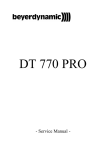Download MINIOPD EXP - OPD EXP BRAKING UNIT USER'S MANUAL
Transcript
MINIOPD EXP - OPD EXP BRAKING UNIT USER’S MANU MANUAL AL EN OPD EXP SUMMARY 1 2 GENERAL DESCRIPTION........................................................................................................... 2 USE LIMITATIONS ...................................................................................................................... 2 2.1 CLIMATIC CLASS................................................................................................................... 2 2.2 RESISTANCE TO CHEMICALLY ACTIVE SUBSTANCES .................................................... 3 2.3 RESISTANCE TO VIBRATIONS............................................................................................. 3 2.4 PROTECTION AND POLLUTION DEGREE ........................................................................... 3 2.5 STORAGE .............................................................................................................................. 4 2.5.1 2.5.2 Storage Environmental Conditions ................................................................................. 4 Recovery Procedure after Storage ................................................................................. 4 3 INSTALLATION INSTRUCTIONS ............................................................................................... 5 3.1 Installation ............................................................................................................................... 5 3.2 Mechanical Dimensions .......................................................................................................... 6 3.3 Confined space: power loss .................................................................................................... 7 3.4 General Features .................................................................................................................... 7 4 POWER PART ............................................................................................................................. 7 4.1 Power Circuit ........................................................................................................................... 7 4.2 Description of the Power Terminals ........................................................................................ 8 4.3 Wiring the Power Part ............................................................................................................. 8 4.4 Power Components................................................................................................................. 9 5 Control Part ................................................................................................................................ 10 5.1 Description of the Terminal Block.......................................................................................... 10 5.2 Description of the Configuration DIP-SWITCHES ................................................................. 11 5.3 Description of Signalling Leds ............................................................................................... 11 5.4 Examples of signal connections ............................................................................................ 12 5.4.1 5.4.2 5.4.3 Wiring as Stand Alone Unit........................................................................................... 12 Wiring for Master – Slave Operation ............................................................................ 13 Wiring for Slave Operation ........................................................................................... 13 Braking Unit User’s Manual Rev. 0.2 – 20.09.11 - EN 1 OPD EXP 1 GENERAL DESCRIPTION This braking module (BRU), along with its braking resistor, is used to limit the DC BUS voltage when power is supplied by a generator, if the line input stage is unable to feed the field power back into the line. This occurs when the input stage consists of a rectifier bridge or a regenerative unit (AFE – Active front End) which goes into current limit, or when line regeneration is disabled. During this operation, the power supplied by the DC BUS (intermediate circuit) is converted into heat dissipated in the external braking resistor. The braking module can work as an independent unit or can be controlled by an external smart unit. It is also possible to use several braking modules connected in parallel, each with its own external braking resistor. 2 USE LIMITATIONS The environmental limitations to the use of the braking module under normal operating conditions are described hereinafter. 2.1 CLIMATIC CLASS Class 3K3 ACCORDING TO EN 60721-3-3 Environmental Parameter Limits (1) operating temperature humidity atmospheric pressure maximum surrounding air velocity maximum temperature gradient maximum thermal radiation condensation precipitation with wind water other than rain ice formation 0÷40 5÷85 70÷106 (2) 1 0.5 700 NO NO (3) NO NO Unit of measurement °C % kPa m/s °C/min W/m2 Table 1 (1) Climatic Class 3K3 envisages a 5÷40°C use limitation; however, the converter can work at a room temperature as low as 0°C. The maximum operating temperature of the converter reaches 45°C without output thermal current derating. (2) The atmospheric pressure limitations correspond to an operating range of 0÷3000m above sea level. At altitudes exceeding 1000 m a.s.l., the rated power of the Braking Unit must be derated by 1% every 100m. (3) The converter must be installed inside a cabinet (never install it outside). 2 Braking Unit User’s Manual Rev. 0.2 – 20.09.11 - EN OPD EXP 2.2 RESISTANCE TO CHEMICALLY ACTIVE SUBSTANCES Class 3C1R according to EN 60721-3-3 Environmental parameter sea salts Maximum value NO Unit of measurement - Environmental parameter hydrofluoric acid Maximum value 0,001 Unit of measurement 3 mg/m sulphur dioxide 0,01 mg/m3 ammonia 0,0012 0,03 cm3/m3 mg/m3 hydrogen sulphide 0,0037 0,0015 cm3/m3 mg/m3 ozone 0,042 0,004 cm3/m3 mg/m3 chlorine 0,001 0,001 cm3/m3 mg/m3 nitrogen oxide 0,002 0,01 cm3/m3 mg/m3 cm3/m3 mg/m3 0,005 cm3/m3 hydrochloric acid 0,00034 0,001 0,00066 cm3/m3 Table 2 2.3 RESISTANCE TO VIBRATIONS As regards vibrations, the Unit has the following limitations: 10Hz ≤ frequency ≤ 57Hz 57Hz ≤ frequency ≤ 150Hz 0.075 1 mm (width) g Table 3 If vibration levels exceed the above values, proper vibration damping measures should be considered. 2.4 PROTECTION AND POLLUTION DEGREE IP20 (1) 2 (2) Protection degree Pollution degree Table 4 (1) With suitable protections on input and output bars Non-conductive pollution and – occasionally and temporarily - conductive pollution generated by condensation. (2) Braking Unit User’s Manual Rev. 0.2 – 20.09.11 - EN 3 OPD EXP 2.5 STORAGE 2.5.1 STORAGE ENVIRONMENTAL CONDITIONS temperature humidity condensation -10÷60 5÷95 NO °C % Table 5 2.5.2 RECOVERY PROCEDURE AFTER STORAGE The drive cannot be used immediately after a storage period. To prevent failures, use the following recovery procedure. STEP 1: temperature humidity condensation atmospheric pressure recovery time (1) Non-powered Converter 15÷35 5÷75 NO 86÷106 1 °C % kPa h Table 6 (1) After this recovery time, there should be no trace of condensation inside or outside the drive (wellventilated environment). STEP 2: For long storage periods (one or more months), always proceed to regenerate the electrolytic capacitors of the power BUS. Leave the converter powered through the + and – terminals for 30min to 1hour, without deriving power from the DC Bus generator. Once the regeneration process has been completed, the converter can work normally. 4 Braking Unit User’s Manual Rev. 0.2 – 20.09.11 - EN OPD EXP 3 3.1 INSTALLATION INSTRUCTIONS INSTALLATION The Braking Unit (BRU) should always be installed in places meeting the environmental requirements in Chapter “Use Limitations”. Moreover, all control and display devices should be easily accessible at all times. Any other equipment must be installed at a reasonable distance from the drive, in order to prevent any metal residues from drilling operations or from metal cables from falling into the drive. Under no circumstances can the converter be mounted near easily flammable material. Figure 1 shows the minimum clearances required to ensure proper cooling of the power part. 150mm 100mm Figure 1 NOTE: Use four M6 screws to fix the Braking Unit to the cabinet panel. Braking Unit User’s Manual Rev. 0.2 – 20.09.11 - EN 5 OPD EXP 3.2 MECHANICAL DIMENSIONS NOTE: To achieve a protection level of IP20, it is necessary to use covers on the outlet bars, wherfore the overall dimensions will change from 403mm to 513mm Figure 2 6 Braking Unit User’s Manual Rev. 0.2 – 20.09.11 - EN OPD EXP 3.3 CONFINED SPACE: POWER LOSS The table below shows the total power loss of a Braking Unit when it is operating at its rated current, including losses due to regulation and ventilation. If the Braking Unit is installed in a confined space, such as a cabinet, make sure that the temperature inside the cabinet does not exceed the maximum ambient temperature allowed for the Braking Unit. If needed, provide sufficient air ventilation to remove the heat generated by the Braking Unit and other components. Size Total Power Loss [A] 85 125 250 [W] 170 240 470 Table 7 3.4 GENERAL FEATURES Braking Unit Size Input voltage Capacity of the intermediate circuit (1) Output thermal current Output peak current Brake activation voltage Brake deactivation voltage 85 [Vdc] [μF] [Adc] [Adc] [Vdc] [Vdc] 125 400÷720 1230 125 250 680 / 730 /770 650 /700 /740 410 85 170 250 1230 250 500 Table 8 NOTE: (1) 1% derating every 100 m, for altitudes exceeding 1000m above sea level. 4 4.1 POWER PART POWER CIRCUIT The power diagram of the Braking Unit (figure 3) consists of the following: Brake IGBT for dissipating the power fed back to the power BUS by the converters Capacity on the intermediate stage Switching mode power supply for generating the power required by the internal logic and the cooling fans + + Capacity F Fly-back IG BT Figure 3 Braking Unit User’s Manual Rev. 0.2 – 20.09.11 - EN 7 OPD EXP 4.2 DESCRIPTION OF THE POWER TERMINALS Table 9 contains a description of the power terminals (power bars) and their meaning. + - Power supply input side (top) Description Terminal + - Power BUS positive terminal Power BUS negative terminal Braking resistor wiring side (bottom) Description Terminal + F Power BUS positive terminal to be used solely for wiring the braking resistor Brake IGBT Collector to be used for wiring the braking resistor Table 9 + F 4.3 WIRING THE POWER PART Figure 4 shows the power connection for the Braking Unit. The fuses and cables to be used are detailed in section 4.4 Power Components. WARNING: When several Braking Units are used (in case of master slave operation, or of several Braking Units controlled by a smart unit) each Braking Unit must have its own braking resistor. In fact, the outputs of two or more Braking Units MAY NOT be connected in parallel. + DC BUS - DC BUS PE Fuses Fuses + - PE + BRAKING UNIT 1 + - PE BRAKING UNIT N + F Braking Resistor 1 F Braking resistor N Figure 4 8 Braking Unit User’s Manual Rev. 0.2 – 20.09.11 - EN OPD EXP 4.4 POWER COMPONENTS Table 10 contains a list of the power components that are recommended to ensure proper operation of the Braking Unit. The fuses indicated are used to protect wiring to the Braking Unit. Size [A] 85 125 250 Ultrafast fuses for cable protection (PVC) 2 Nominal current rating I T fuses < 2 I T cable @5s [A] 160-450 200-630 400-1250 [KA s] <16200 <33062 <190440 2 @ Tambient=40°C Wiring cable section Minimum shortcircuit current Fuse voltage Section of + , - , + , F cables [A] 1800 2571 6172 [Vac] 690 690 690 [mm ] 35 50 120 2 Section of GROUND cable 2 [mm ] 25 35 70 Table 10 Table 11 indicates the minimum values of the external braking resistors as a function of the activation voltage of the braking circuit itself. This table also shows the maximum thermal capacities and maximum peak capacities at the minimum resistance value of the braking resistor. Size Minimum value of braking resistor [A] 85 125 250 680V [Ω] 4 2,7 1,4 730V [Ω] 4,3 2,9 1,45 770V [Ω] 4,5 3,1 1,54 Maximum thermal capacity at minimum resistance 680V 730V 770V [KW] [KW] [KW] 57,8 62,1 65,5 85,0 91,3 96,3 170,0 182,5 192,5 Maximum peak capacity at minimum resistance 680V 730V 770V [KW] [KW] [KW] 115,6 124,1 130,9 170,0 182,5 192,5 340,0 365,0 385,0 Table 11 Braking Unit User’s Manual Rev. 0.2 – 20.09.11 - EN 9 OPD EXP 5 CONTROL PART 5.1 DESCRIPTION OF THE TERMINAL BLOCK Table 12 provides the details for the control terminal block and fiber optics. Terminal M1-1 M1-2 M1-3 +24VOUT 0POUT BRAKE EN. Description Output auxiliary voltage 21.6÷26.5V as referred to 0POUT. Maximum output current 100mA. +24VOUT auxiliary voltage common. Logic input. Enables the braking circuit. This input is optoisolated from the internal regulation and is referred to 0V BR EN. (M1-4). This logic input is in parallel with the brake activation command supplied via fiber optics (BRAKE EN.) and with the command that is generated internally (when the slave function is disabled). M1-4 M1-5 0V BR EN. L.O.1 M1-6 /L.O.1 M1-7 L.O.2 Imax=60mA, Vmax=30V Pre-alarm logic input: the radiator temperature is approaching the alarm threshold. M1-8 /L.O.2 This logic output is optoisolated from the internal regulation. The transistor is conductive when this output is active. M1-9 DR OK N.O. Imax=60mA, Vmax=30V DRIVE OK logic output M1-10 DR OK COM M1-11 DR OK N.C. M1-12 M1-13 0V VBUS M1-14 SHIELD Input voltage range 21.6÷26.5V, absorbed current 10mA. BRAKE EN. (M1-3) logic input common. Logic output for activating the braking circuit. This logic output is optoisolated from the internal regulation. The transistor is conductive when this output is active. Clean contact relay (energised under normal operating conditions) Features of the relay: 250VAC 8A. DR OK N.C. Internal regulation common. Logic output as referred to 0V (M1-12) and proportional to the BUS voltage (ratio 1:100). Output: +8V / 2mA FIBRE OPTICS BRAKE EN. Description Logic input. Enables the braking circuit. Light on = braking is active DRIVE OK This logic input is in parallel with the brake activation command supplied via terminal M1-3 (BRAKE EN.) and with the command that is generated internally (when the slave function is disabled). DRIVE OK logic output Light on = No alarm present Table 12 10 Braking Unit User’s Manual Rev. 0.2 – 20.09.11 - EN OPD EXP 5.2 DESCRIPTION OF THE CONFIGURATION DIP-SWITCHES On the front panel there are two Dip-switches that enable users to customize their Braking Unit. The first Dip-switch enables the setting of up to three different activation voltages for the braking circuit. By contrast, the second one enables the user to operate the Braking Unit as if it were controlled from outside (that is, as a slave only). Table 13 provides a description of these Dip-switches. SW1: used to set the brake activation and deactivation thresholds SW1-2 Brake activation voltage Brake deactivation voltage [Vdc] [Vdc] OFF 680 650 OFF 730 700 ON 770 740 ON 770 740 SW1-1 OFF ON OFF ON SW2-1 SW2-2 OFF X ON X SW2: used to set the unit for slave operation Description The internal brake activation circuit, which goes in parallel with the brake activation commands supplied via logic inputs (terminal M1-3 or fiber optics BRAKE EN.), is on. The brake activation command is supplied solely and exclusively via logic inputs (terminal M1-3 or fiber optics BRAKE EN.) The Braking Unit operates as a SLAVE. Table 13 5.3 DESCRIPTION OF SIGNALLING LEDS On the front panel of the Braking Unit there are some signalling leds. They allow the users to check the configuration of the Unit itself and provide immediate troubleshooting information in case of an alarm. Their meaning is shown in Table 14 Name 680V 730V 770V SLAVE DRIVE OK MAX VOLT MIN VOLT OVER TEMP POWER FAULT Signalling leds Description Brake activation voltage is set to 680Vdc (when this led is on). Brake activation voltage is set to 730Vdc (when this led is on). Brake activation voltage is set to 770Vdc (when this led is on). Operation as a SLAVE: the brake activation command is supplied solely and exclusively via logic inputs (terminal M1-3 or fiber optics BRAKE EN.) (steady on = operation as a SLAVE) This led indicates that the drive is ready (steady on = OK) DC BUS overvoltage alarm (led on = alarm). DC BUS undervoltage alarm (led on = alarm). Heat sink overtemperature alarm (led on = alarm). Brake IGBT power fault alarm (led on = alarm). Table 14 Braking Unit User’s Manual Rev. 0.2 – 20.09.11 - EN 11 OPD EXP 5.4 EXAMPLES OF SIGNAL CONNECTIONS 5.4.1 Wiring as Stand Alone Unit M1-3 BRAKE EN +24VOUT 0POUT M1-4 0V BR EN L.O.1 M1-1 M1-2 To the control for common zeros M1-5 M1-6 /L.O.1 L.O.2 M1-7 M1-8 /L.O.2 DR OK COM DR OK NC M1-9 M1-10 M1-11 DR OK NO 0V 100 To the control for pre alarm signals To the control for alarm signals M1-12 M1-13 VBUS SC HIELD M1-14 Figure 5 The “brake enable” command is generated internally. The logic outputs and analog signal are used merely for diagnostic purposes (troubleshooting). 12 Braking Unit User’s Manual Rev. 0.2 – 20.09.11 - EN OPD EXP 5.4.2 Wiring for Master – Slave Operation In the diagram below, the “Master” supplies the brake activation command to the slave via the L.O.1 logic output. If you wish to set up the second Braking Unit as a slave, follow the instructions provided in section 5.2 Description of the Configuration DIP-SWITCHES. The series of the two DRIVE OK clean contacts is wired to the control for diagnostic purposes. You can also use the series of L.O.2 logic outputs for the purpose of recognizing any pre-alarm condition on one of the two Braking Units. Finally, you can also use a master-slave configuration with several slaves. All you have to do is connect the L.O.1 logic output of the master to all BRAKE EN inputs (the 0POUT of the master must be connected in common to the 0V BR EN of the slaves). All DRIVE OK contacts must be placed in series, so as to send any alarms to the control. M1-3 BRAKE EN +24VOUT 0POUT M1-4 0V BR EN L.O.1 M1-1 To the control for common zeros M1-2 M1-3 BRAKE EN +24VOUT 0POUT M1-4 0V BR EN M1-5 L.O.1 L.O.2 M1-7 M1-8 M1-9 DR OK COM DR OK NC M1-10 0V M1-12 100 M1-13 M1-10 M1-12 M1-13 VBUS VBUS SC HIELD To the control for alarm signals DR OK NO DR OK NO 0V M1-9 M1-11 M1-11 100 M1-7 /L.O.2 /L.O.2 DR OK NC M1-5 /L.O.1 M1-8 DR OK COM M1-2 M1-6 M1-6 /L.O.1 L.O.2 M1-1 M1-14 SCHIELD MASTER M1-14 SLAVE Figure 6 5.4.3 Wiring for Slave Operation This Braking Unit can be configured to operate as a slave and to receive the brake activation command and supply the DRIVE OK signal to a smart unit, via fiber optics. The smart unit can receive the signal proportional to the power BUS voltage from the Braking Unit itself. The wiring diagram to be used in this case is shown in the following figure. Braking Unit User’s Manual Rev. 0.2 – 20.09.11 - EN 13


















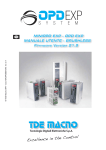

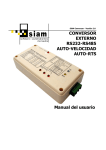



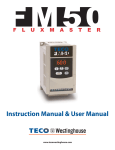

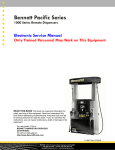
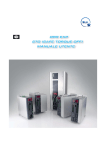
![Pages from [MOPDE user manual]](http://vs1.manualzilla.com/store/data/006911906_1-d85ec144d02a745e36305fe213dcdcbe-150x150.png)
